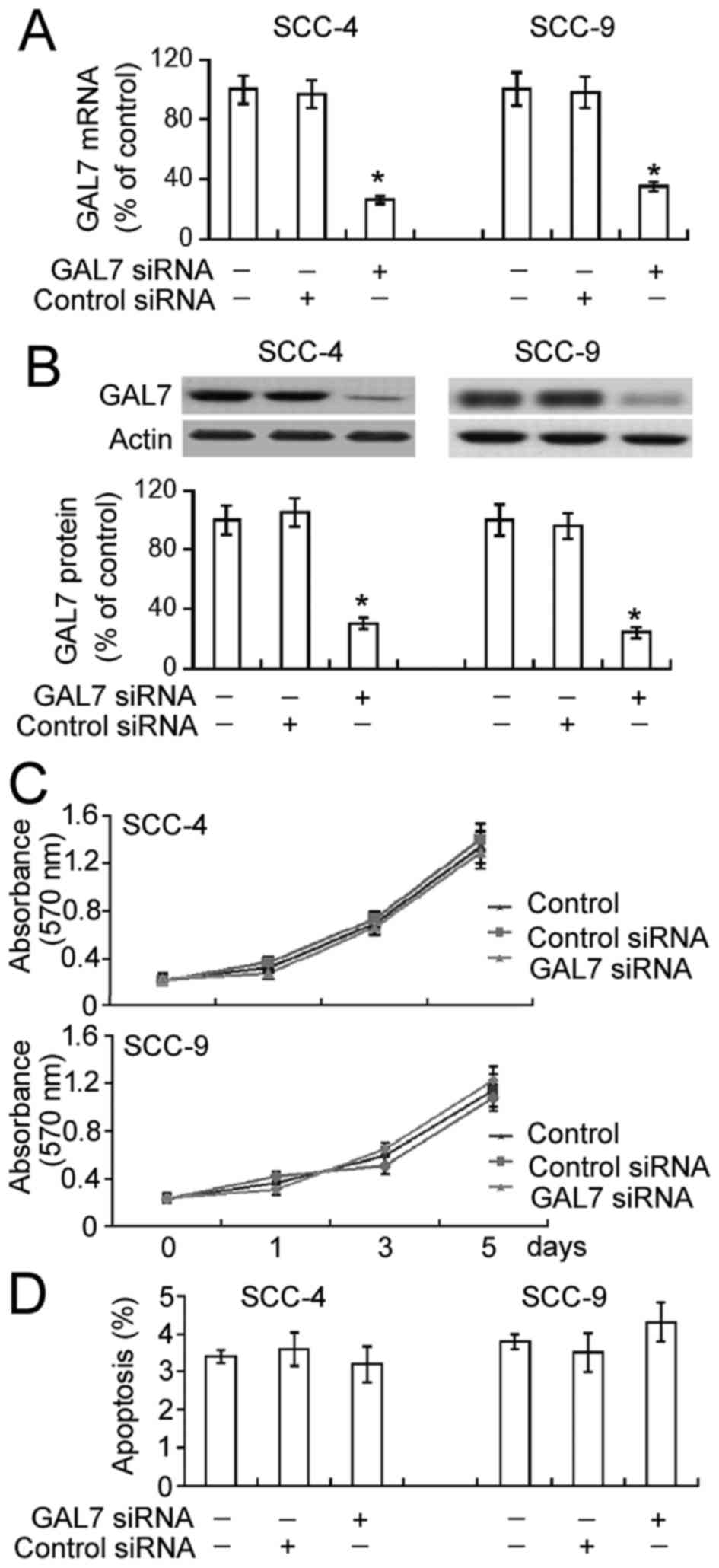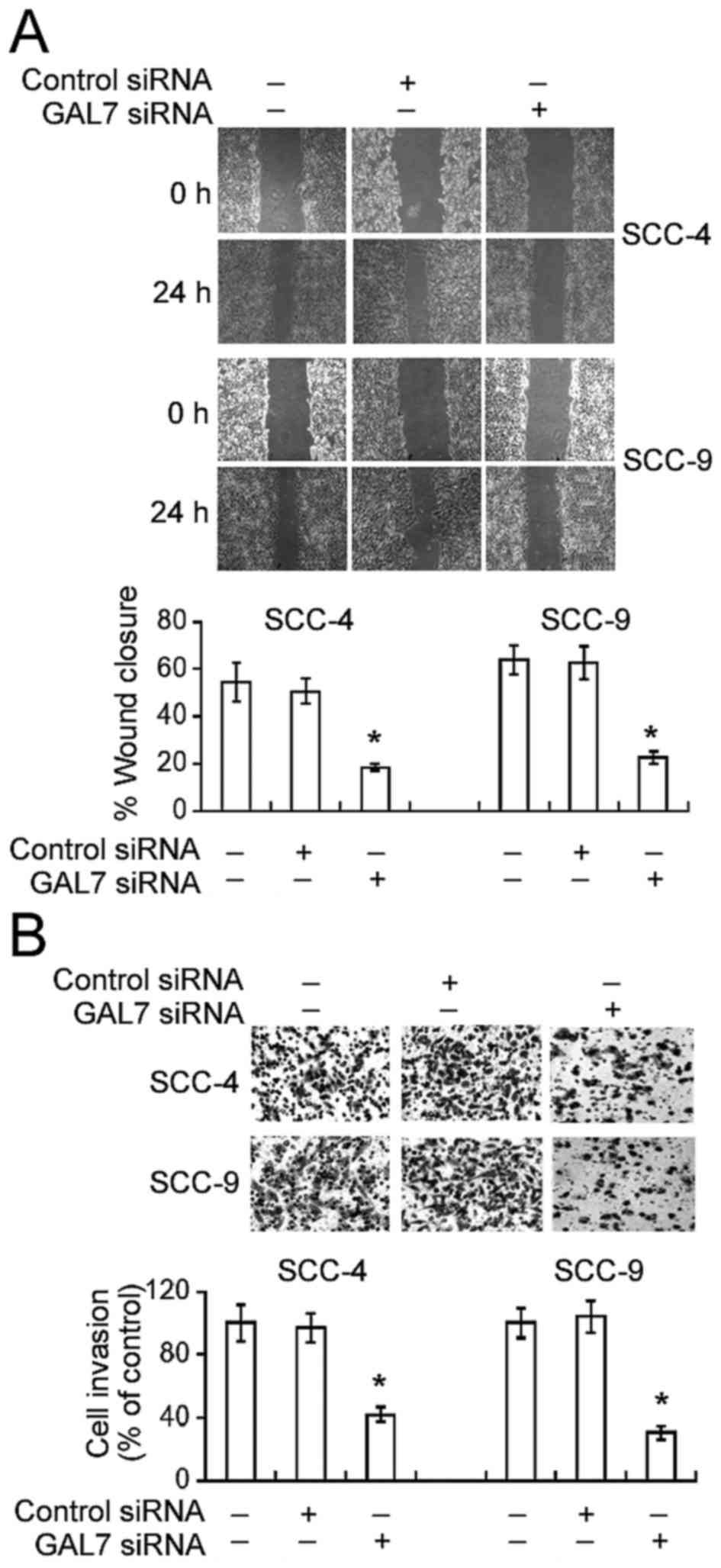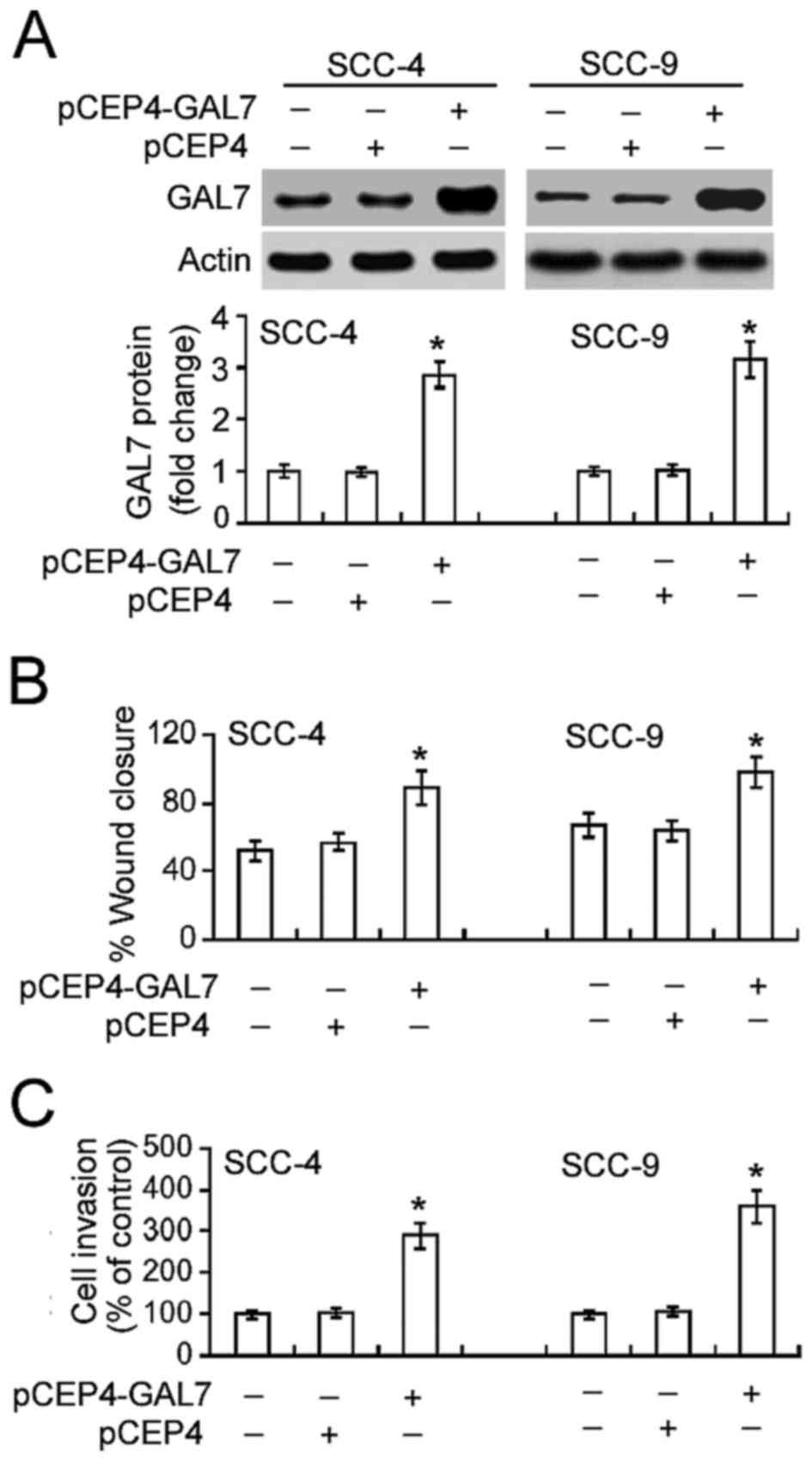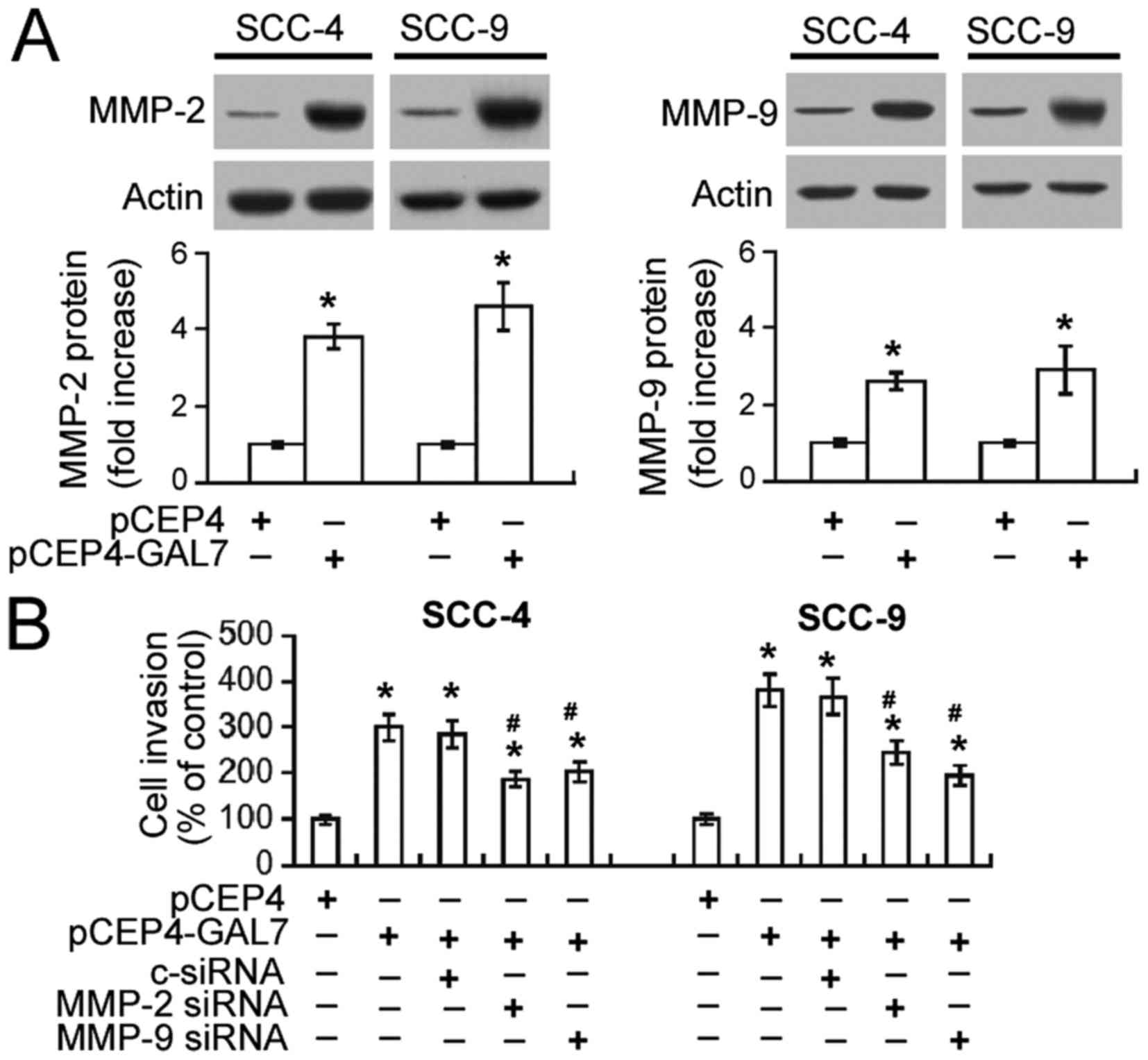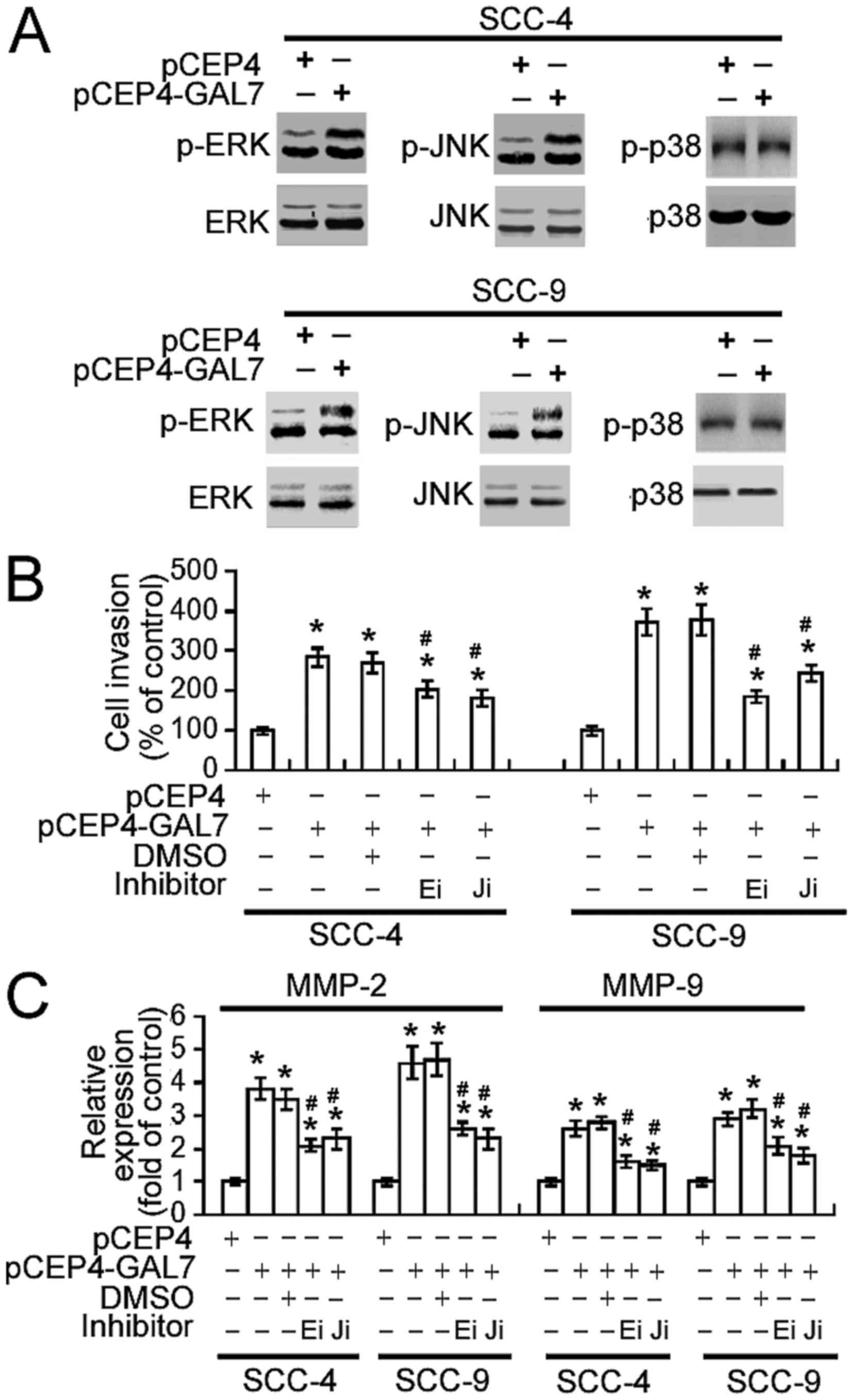Galectin‑7 promotes the invasiveness of human oral squamous cell carcinoma cells via activation of ERK and JNK signaling
- Authors:
- Published online on: January 25, 2017 https://doi.org/10.3892/ol.2017.5649
- Pages: 1919-1924
Abstract
Introduction
Oral squamous cell carcinoma (OSCC) is one of the most common malignancies in the world, and has a high mortality rate (1). Invasive growth via the lymphatic route is a typical feature of OSCC (2) and lymph node involvement status has been identified as a reliable prognostic indicator in OSCC patients (3,4). Therefore, a number of studies are underway in order to investigate the molecular mechanisms involved in regulating OSCC invasiveness (5).
Galectin-7 is a member of the β-galactoside-binding protein family. It is predominantly expressed in epithelial cells within healthy tissue and plays an important role in epithelial development and homeostasis (6,7). Galectin-7 expression may be altered in epithelial cancer, therefore it may serve an important role in cancer progression (8). The exact role of galectin-7 may vary in different types of cancers; it may play distinct and even opposing roles in tumor development. For example, in human gastric cancer specimens, galectin-7 is underexpressed due to epigenetic modifications and this suppresses the proliferation and invasion of gastric cancer cells (9). By contrast, in high-grade breast cancer galectin-7 is overexpressed, facilitating the spontaneous metastasis of breast cancer cells in preclinical mouse models (10). The tumor-promoting role of galectin-7 has also been noted in ovarian cancer cells (11) and cervical cancer cells (12).
Previous studies have demonstrated that galectin-7 increases the expression of matrix metalloproteinases (MMPs), especially MMP-9, thus modulating the invasiveness of cancer cells (11,12). Additionally, OSCC tissues exhibit increased MMP-2 and MMP-9 activity compared with adjacent healthy tissues (13). It has previously been demonstrated that MMPs serve a critical role in the invasion and metastasis of oral cancer (14). Alves et al (15) reported that galectin-7 is highly expressed in OSCC and its expression is significantly correlated with the histological grade of disease. These findings suggest that galectin-7 may contribute to OSCC invasiveness by modulating the expression of MMP-2 and MMP-9. The present study investigated the effects of manipulating galectin-7 expression on the biological phenotypes of human OSCC cells and evaluated the involvement of MMP-2 and MMP-9 on the action of galectin-7.
Materials and methods
Cell culture and treatment
The human OSCC cell lines SCC-4 and SCC-9 were purchased from the American Type Culture Collection (ATCC; Manassas, VA, USA). All cells were maintained at 37°C in 5% CO2 in Dulbecco's Modified Eagle's Medium supplemented with 10% fetal bovine serum (FBS), 1 mmol/l L-glutamine, and 100 U/ml penicillin, 100 µg/ml streptomycin (all from Invitrogen; Thermo Fisher Scientific, Inc., Waltham, MA, USA). For inhibitor experiments, cells were pretreated with the c-Jun N-terminal kinase (JNK) inhibitor SP600125 (10 µM; Calbiochem; EMD Millipore, Billerica, MA, USA), extracellular signal-related kinase (ERK) inhibitor PD98059 (10 µM; Calbiochem; EMD Millipore), or 0.1% dimethyl sulfoxide (DMSO) used as vehicle control 1 h before transfection of galectin-7-expressing plasmid.
Plasmids, small interfering RNA (siRNA), and transfection
A galectin-7-expressing plasmid (pCEP4-GAL7) was purchased from Addgene (Cambridge, MA, USA) and an empty vector (pCEP4) was also purchased (Invitrogen; Thermo Fisher Scientific, Inc.) Galectin-7 siRNA, MMP-2 siRNA, MMP-9 siRNA, and negative control siRNA were obtained from Santa Cruz Biotechnology (Dallas, TX, USA). For overexpression or knockdown of galectin-7, cells were seeded onto 6-well plates (4×105 cells/well) and transfected with 1 µg pCEP4-GAL7, 1 µg pCEP4 and 50 nM galectin-7 siRNA, or 50 nM control siRNA using Lipofectamine® 2000 (Invitrogen; Thermo Fisher Scientific, Inc.), according to the manufacturer's instructions. Cells were incubated for 24 h, and subsequently collected for further experiments. To validate the involvement of MMP-2 and MMP-9, cells were co-transfected with 1 µg pCEP4-GAL7 and 50 nM MMP-2 siRNA, MMP-9 siRNA, or control siRNA, and tested for invasive ability following incubation for 24 h.
Cell proliferation assay
Cell proliferation was measured using the MTT assay. Transfected cells were detached and re-seeded onto 96-well plates (2×103/well). Following incubation for 1, 3, and 5 days, 0.5 mg/ml MTT (Sigma-Aldrich; Merck Millipore, Darmstadt, Germany) was added to the culture and incubated for additional 4 h at 37°C. Formazan crystals were dissolved in DMSO. Absorbance was measured at 570 nm using a multi-plate reader.
Apoptosis detection assay
Apoptosis analysis was performed using the Annexin V-FITC Apoptosis Detection kit (Nanjing KeyGen Biotech Co., Nanjing, China), according to the manufacturer's instructions. In brief, cells were incubated with a staining solution containing fluorescein isothiocyanate (FITC)-conjugated annexin-V and propidium iodide (PI) for 10 min at 4°C in the dark. The percentage of apoptotic cells was determined using a FACScan flow cytometer with the CellQuest software (BD Biosciences, San Jose, CA, USA).
Wound-healing assay
Cells were seeded onto 6-well plates and allowed to grow to ~95% confluence. A wound was made in the monolayer using a 100-µl pipette tip. The culture was washed to remove cellular debris and incubated for 24 h at 37°C. Cells were imaged using a phase contrast microscope at different time points. The extent of wound closure was quantified by measuring its area before migration, and 24 h after migration. Results were expressed as percentage of wound closure.
Transwell invasion assay
Invasion assays were performed using Transwell chambers, which were coated with Matrigel (BD Biosciences) 24 h prior to use. The cells were subsequently harvested and resuspended in serum-free medium containing 1% bovine serum albumin (Sigma-Aldrich; Merck Millipore). The cell suspension was added to the upper chamber and the lower chamber was filled with culture medium containing 10% FBS. After incubation for 24 h at 37°C, cells on the upper surface of the chamber were removed using a cotton swab. Invaded cells on the lower surface were fixed in 4% formaldehyde, stained with 0.5% crystal violet, and counted under a microscope.
Reverse transcription-quantitative polymerase chain reaction (RT-qPCR) analysis
Total RNA was extracted from cells using the TRIzol reagent following the manufacturer's instructions (Invitrogen; Thermo Fisher Scientific, Inc.). Reverse transcription was performed using the PrimeScript First Strand cDNA Synthesis kit (Takara Biotechnology Co., Dalian, China). RT-qPCR was performed on an ABI 7500 Fast Real-Time PCR System (Applied Biosystems; Thermo Fisher Scientific, Inc.) with SYBR-Green detection mix (Takara Biotechnology Co.). The following primers were used in the current study: Galectin-7 forward 5′-TTGCTCCTTGCTGTTGAAGACCAC-3′, and reverse 5′-AGGTTCCATGTAAACCTGCTGTGC-3′ (16); glyceraldehyde-3-phosphate dehydrogenase (GAPDH) forward, 5′-TGACTTCAACAGCGACACCCA-3′; and reverse, 5′-CACCCTGTTGCTGTAGCCAAA-3′. PCR conditions were as follows: 95°C for 5 min, followed by 40 cycles of 95°C for 10 sec, 64°C for 30 sec, and 72°C for 30 sec. The relative galectin-7 mRNA level was calculated using the 2−ΔΔCq method (17) following normalization against the level of GAPDH.
Western blot analysis
Cells were lysed in radioimmunoprecipitation assay buffer (phosphate buffer solution, 1% NP40, 0.5% sodium deoxycholate, 0.1% sodium dodecyl sulphate) containing a protease inhibitor cocktail (Cell Signaling Technology, Inc., Danvers, MA, USA) on ice for 30 min. After centrifugation at 15,000 × g for 20 min, the supernatant was collected and protein concentrations were measured using a protein assay kit (Bio-Rad Laboratories, Inc., Hercules, CA, USA). Cell lysates were separated by sodium dodecyl sulfate-polyacrylamide gel electrophoresis and transferred onto nitrocellulose membranes. Membranes were probed with the following antibodies at 1:300 dilution: Rabbit anti-galectin-7 monoclonal antibody (cat. no. ab108623), rabbit anti-MMP-2 polyclonal antibody (cat. no. ab97779), mouse anti-MMP-9 monoclonal antibody (cat. no. ab119906), rabbit anti-GAPDH monoclonal antibody (cat. no. ab181602; all from Abcam, Cambridge, MA, USA), rabbit anti-phospho-ERK1/2 polyclonal antibody (cat. no. 9101), rabbit anti-ERK1/2 polyclonal antibody (cat. no. 9102), rabbit anti-phospho-JNK monoclonal antibody (cat. no. 4668), rabbit anti-JNK polyclonal antibody (cat. no. 9252), rabbit anti-phospho-p38 monoclonal antibody (cat. no. 4511) and rabbit anti-p38 monoclonal antibody (cat. no. 8690; all from Cell Signaling Technology, Inc.). Horseradish peroxidase-conjugated secondary antibodies (cat. nos. sc-2004 and sc-2005; Santa Cruz Biotechnology, Inc.) were diluted at 1:2,000 prior to use. Proteins were visualized using an enhanced chemiluminescence kit (Pierce Biotechnology, Inc., Rockford, IL, USA). The blots were quantified by densitometry with the Quantity One software (Bio-Rad Laboratories).
Statistical analysis
Data are expressed as mean ± standard deviation. Statistical differences were examined using one-way analysis of variance (ANOVA) followed by Tukey's post hoc test. P<0.05 was considered to indicate a statistically significant difference.
Results
Galectin-7 silencing has no impact on cell proliferation or apoptosis in OSCC cells
To analyze the role of galectin-7 in the proliferation of OSCC cells, galectin-7-specific siRNA was transiently transfected into SCC-4 and SCC-9 cell lines. The delivery of galectin-7 siRNA significantly decreased mRNA and protein levels of endogenous galectin-7 in both SCC-4 and SCC-9 cells (Fig. 1A and B; P<0.05). The results of the MTT assay demonstrated that this downregulation of galectin-7 did not significantly affect SCC-4 and SCC-9 cell proliferation compared with non-transfected cells over a 5-day period (Fig. 1C). Annexin-V/PI staining analysis identified comparable percentages of apoptotic cells in non-transfected and galectin-7 siRNA-transfected cells (Fig. 1D).
Galectin-7 knockdown attenuates the migration and invasion of OSCC cells
The effect of galectin-7 downregulation on the invasive properties of OSCC cells was then analyzed. Galectin-7 silencing caused a significant decline in cell motility during in vitro wound-healing assays. Compared to non-transfected SCC-4 cells, the percentage wound closure was significantly lower in galectin-7-silenced SCC-4 cells 24 h following incubation (18.5±3.2% vs. 54.4±6.4%, P<0.05; Fig. 2A). Similarly, galectin-7 siRNA transfection resulted in a significant reduction in the motility of SCC-9 cells (P<0.05). Matrigel invasion assays demonstrated that galectin-7 knockdown significantly reduced the numbers of invaded cells by >60%, compared with non-transfected cells (P<0.05; Fig. 2B).
Overexpression of galectin-7 accelerates the migration and invasion of OSCC cells
Further tests confirmed the effect of increased galectin-7 on the migration and invasion of OSCC cells. Transfection of the plasmid pCEP4-GAL7 into SCC-4 and SCC-9 cells led to a significant increase in galectin-7 expression compared with non-transfected cells (Fig. 3A). This increase in galectin-7 expression in turn significantly increased OSCC cell migration and invasion (P<0.05; Figs. 3B and C).
Upregulation of MMP-2 and MMP-9 mediates the pro-invasive activity of galectin-7
A possible association between galectin-7-mediated invasiveness and MMP-2 and MMP-9 upregulation was investigated. Western blot analysis demonstrated that galectin-7 overexpression resulted in a 3–5-fold increase in MMP-2 protein and 2–3-fold increase in MMP-9 protein expression in both SCC-4 and SCC-9 cells (Fig. 4A). Transwell invasion assay demonstrated that the invasiveness of SCC-4 and SCC-9 cells overexpressing galectin-7 was significantly decreased by co-transfection with MMP-2 or MMP-9-specific siRNA (P<0.05; Fig. 4B).
Galectin-7 promotes OSCC cell invasion via activation of ERK and JNK signaling
Finally, the signaling pathways involved in the action of galectin-7 were investigated. As shown in Fig. 5A, increasing galectin-7 expression markedly enhanced the phosphorylation of ERK1/2 and JNK1/2 in SCC-4 and SCC-9 cells, without altering total levels of ERK1/2 and JNK1/2. No change in p38 phosphorylation levels was detected. Notably, the pharmacological inhibition of ERK or JNK activity significantly suppressed the invasiveness of galectin-7-overexpressing SCC-4 and SCC-9 cells (P<0.05; Fig. 5B) and abrogated the upregulation of MMP-2 and MMP-9 (P<0.05; Fig. 5C).
Discussion
Matsukawa et al (18) reported previously that adenoviral delivery of the galectin-7 gene may induce modest apoptosis and reduce the viability of human OSCC HSC3 cells. However, knockdown of galectin-7 using antisense galectin-7 oligonucleotides demonstrated no significant effects on cell viability. In the current study, the biological roles of galectin-7 in two other OSCC cell lines were explored, and targeted reduction of galectin-7 via siRNA technology did not alter viability and spontaneous apoptosis in SCC-4 and SCC-9 cells. These results suggest that galectin-7 is not required for the maintenance of OSCC cell viability. The anti-viability effect elicited by overexpression of galectin-7 may only reflect a non-specific cytotoxicity, as the potential cytotoxic activity of galectin-7 overexpression on healthy human cells was not tested in the current study.
The ability of galectin-7 to modulate cell behavior seems to be cell-dependent. Previous studies have demonstrated that overexpressing galectin-7 inhibits the proliferation of several specific cancer cells such as gastric cancer cells (9) and colon carcinoma cells (19). However, in other cancer cells including epithelial ovarian cancer (20), galectin-7 was involved in cell proliferation, as its downregulation inhibited the proliferation of A2780-PAR ovarian cancer cell.
Metastasis is the main cause of cancer-associated mortality. Galectin-7 exhibits the ability to modulate the metastatic phenotype of several types of cancer cells (10,12,21). Demers et al (21) demonstrated that ectopic expression of galectin-7 increases the invasiveness of lymphoma, accelerates the development of thymic lymphoma, and previously identified that overexpressing galectin-7 enhances the metastatic growth of breast cancer cells in the lungs and bones in two different mouse models (10). Enforced expression of galectin-7 also promotes the invasiveness of human HeLa cervical epithelial adenocarcinoma cells (12). The results of the present study are consistent with results from previous studies, as they demonstrated that galectin-7 has the ability to modulate the invasive properties of OSCC cells. Knockdown of galectin-7 suppressed the migration and invasion of SCC-4 and SCC-9 cells, whereas overexpressing galectin-7 increased them. Taken together, these findings indicate that galectin-7 is a potential target for the treatment of tumor dissemination in OSCC.
Compelling evidence suggests that the induction of MMPs plays a pivotal role in the OSCC invasiveness. For instance, Bedal et al (22) have previously reported that collagen XVI facilitates the invasion of OSCC cells by inducing MMP-9 expression. It has previously been suggested that the downregulation of MMP-2 and MMP-9 may account for the decreased invasiveness of OSCC cells due to the knockdown of BubR1, a critical component of spindle assembly checkpoint (23). Inhibiting MMP-2 and MMP-9 expression has also been demonstrated to mediate the anti-invasive effects of curcumin (a natural polyphenolic compound) in OSCC cells (24). In line with its pro-invasive activity, galectin-7 expression increases the expression of MMP-9 in several cancer cells (12,16,21). The current study investigated the effects of MMP-2 and MMP-9 on galectin-7 action in OSCC cells. Galectin-7 overexpression resulted in the significant upregulation of MMP-2 and MMP-9. Most importantly, silencing MMP-2 or MMP-9 significantly impaired the invasiveness of OSCC cells that overexpressed galectin-7. Thus MMP-2 and MMP-9 may be required for the galectin-7-mediated invasiveness of OSCC cells.
To gain a better insight into the function of galectin-7 in OSCC cell invasiveness, the signaling pathways involved were analyzed. Since mitogen-activated protein kinase (MAPK) pathways are implicated in the invasion of oral cancer cells (25,26) and galectin-7 may activate p38 MAPK signaling in cervical cancer cells (12), the current study investigated the importance of MAPK signaling in mediating galectin-7 action. The results of the present study demonstrated that galectin-7 overexpression leads to the phosphorylation and activation of ERKs and JNKs, but not p38 MAPK, in SCC-4 and SCC-9 cells. Interestingly, the pharmacological inhibition of ERK or JNK activity significantly attenuated OSCC cell invasiveness induced by galectin-7 overexpression. Moreover, galectin-7-mediated upregulation of MMP-2 and MMP-9 was compromised by pretreatment with the ERK or JNK inhibitors. Taken together, these results suggest that galectin-7 promotes the invasiveness of OSCC cells largely by inducing the expression of MMP-2 and MMP-9 via activation of ERK and JNK signaling.
In conclusion, the current study provides novel evidence demonstrating the pro-invasive activity of galectin-7, which is associated with increased MMP-2 and MMP-9 expression, in OSCC cells. Furthur studies are required to investigate the utility of galectin-7 as a target for the treatment of metastatic OSCC.
References
|
Torre LA, Bray F, Siegel RL, Ferlay J, Lortet-Tieulent J and Jemal A: Global cancer statistics, 2012. CA Cancer J Clin. 65:87–108. 2015. View Article : Google Scholar : PubMed/NCBI | |
|
Ziober AF, Falls EM and Ziober BL: The extracellular matrix in oral squamous cell carcinoma: Friend or foe? Head Neck. 28:740–749. 2006. View Article : Google Scholar : PubMed/NCBI | |
|
Künzel J, Mantsopoulos K, Psychogios G, Grundtner P, Koch M and Iro H: Lymph node ratio as a valuable additional predictor of outcome in selected patients with oral cavity cancer. Oral Surg Oral Med Oral Pathol Oral Radiol. 117:677–684. 2014. View Article : Google Scholar : PubMed/NCBI | |
|
Kim SY, Nam SY, Choi SH, Cho KJ and Roh JL: Prognostic value of lymph node density in node-positive patients with oral squamous cell carcinoma. Ann Surg Oncol. 18:2310–2317. 2011. View Article : Google Scholar : PubMed/NCBI | |
|
Sasahira T, Kirita T and Kuniyasu H: Update of molecular pathobiology in oral cancer: A review. Int J Clin Oncol. 19:431–436. 2014. View Article : Google Scholar : PubMed/NCBI | |
|
Magnaldo T, Fowlis D and Darmon M: Galectin-7, a marker of all types of stratified epithelia. Differentiation. 63:159–168. 1998. View Article : Google Scholar : PubMed/NCBI | |
|
Rondanino C, Poland PA, Kinlough CL, Li H, Rbaibi Y, Myerburg MM, Al-bataineh MM, Kashlan OB, Pastor-Soler NM, Hallows KR, et al: Galectin-7 modulates the length of the primary cilia and wound repair in polarized kidney epithelial cells. Am J Physiol Renal Physiol. 301:F622–F633. 2011. View Article : Google Scholar : PubMed/NCBI | |
|
St-Pierre Y, Campion CG and Grosset AA: A distinctive role for galectin-7 in cancer? Front Biosci (Landmark Ed). 17:438–450. 2012. View Article : Google Scholar : PubMed/NCBI | |
|
Kim SJ, Hwang JA, Ro JY, Lee YS and Chun KH: Galectin-7 is epigenetically-regulated tumor suppressor in gastric cancer. Oncotarget. 4:1461–1471. 2013. View Article : Google Scholar : PubMed/NCBI | |
|
Demers M, Rose AA, Grosset AA, Biron-Pain K, Gaboury L, Siegel PM and St-Pierre Y: Overexpression of galectin-7, a myoepithelial cell marker, enhances spontaneous metastasis of breast cancer cells. Am J Pathol. 176:3023–3031. 2010. View Article : Google Scholar : PubMed/NCBI | |
|
Labrie M, Vladoiu MC, Grosset AA, Gaboury L and St-Pierre Y: Expression and functions of galectin-7 in ovarian cancer. Oncotarget. 5:7705–7721. 2014. View Article : Google Scholar : PubMed/NCBI | |
|
Park JE, Chang WY and Cho M: Induction of matrix metalloproteinase-9 by galectin-7 through p38 MAPK signaling in HeLa human cervical epithelial adenocarcinoma cells. Oncol Rep. 22:1373–1379. 2009.PubMed/NCBI | |
|
Patel BP, Shah PM, Rawal UM, Desai AA, Shah SV, Rawal RM and Patel PS: Activation of MMP-2 and MMP-9 in patients with oral squamous cell carcinoma. J Surg Oncol. 90:81–88. 2005. View Article : Google Scholar : PubMed/NCBI | |
|
Thomas GT, Lewis MP and Speight PM: Matrix metalloproteinases and oral cancer. Oral Oncol. 35:227–233. 1999. View Article : Google Scholar : PubMed/NCBI | |
|
Alves PM, Godoy GP, Gomes DQ, Medeiros AM, de Souza LB, da Silveira EJ, Vasconcelos MG and Queiroz LM: Significance of galectins-1, −3, −4 and −7 in the progression of squamous cell carcinoma of the tongue. Pathol Res Pract. 207:236–240. 2011. View Article : Google Scholar : PubMed/NCBI | |
|
Demers M, Biron-Pain K, Hébert J, Lamarre A, Magnaldo T and St-Pierre Y: Galectin-7 in lymphoma: Elevated expression in human lymphoid malignancies and decreased lymphoma dissemination by antisense strategies in experimental model. Cancer Res. 67:2824–2829. 2007. View Article : Google Scholar : PubMed/NCBI | |
|
Giulietti A, Overbergh L, Valckx D, Decallonne B, Bouillon R and Mathieu C: An overview of real-time quantitative PCR: Applications to quantify cytokine gene expression. Methods. 25:386–401. 2001. View Article : Google Scholar : PubMed/NCBI | |
|
Matsukawa S, Morita K, Negishi A, Harada H, Nakajima Y, Shimamoto H, Tomioka H, Tanaka K, Ono M, Yamada T and Omura K: Galectin-7 as a potential predictive marker of chemo- and/or radio-therapy resistance in oral squamous cell carcinoma. Cancer Med. 3:349–361. 2014. View Article : Google Scholar : PubMed/NCBI | |
|
Ueda S, Kuwabara I and Liu FT: Suppression of tumor growth by galectin-7 gene transfer. Cancer Res. 64:5672–5676. 2004. View Article : Google Scholar : PubMed/NCBI | |
|
Kim HJ, Jeon HK, Lee JK, Sung CO, Do IG, Choi CH, Kim TJ, Kim BG, Bae DS and Lee JW: Clinical significance of galectin-7 in epithelial ovarian cancer. Anticancer Res. 33:1555–1561. 2013.PubMed/NCBI | |
|
Demers M, Magnaldo T and St-Pierre Y: A novel function for galectin-7: Promoting tumorigenesis by up-regulating MMP-9 gene expression. Cancer Res. 65:5205–5210. 2005. View Article : Google Scholar : PubMed/NCBI | |
|
Bedal KB, Grässel S, Oefner PJ, Reinders J, Reichert TE and Bauer R: Collagen XVI induces expression of MMP9 via modulation of AP-1 transcription factors and facilitates invasion of oral squamous cell carcinoma. PLoS One. 9:e867772014. View Article : Google Scholar : PubMed/NCBI | |
|
Chou CK, Wu CY, Chen JY, Ng MC, Wang HM, Chen JH, Yuan SS, Tsai EM, Chang JG and Chiu CC: BubR1 acts as a promoter in cellular motility of human oral squamous cancer cells through regulating MMP-2 and MMP-9. Int J Mol Sci. 16:15104–15117. 2015. View Article : Google Scholar : PubMed/NCBI | |
|
Lee AY, Fan CC, Chen YA, Cheng CW, Sung YJ, Hsu CP and Kao TY: Curcumin inhibits invasiveness and epithelial-mesenchymal transition in oral squamous cell carcinoma through reducing matrix metalloproteinase 2, 9 and modulating p53-E-cadherin pathway. Integr Cancer Ther. 14:484–490. 2015. View Article : Google Scholar : PubMed/NCBI | |
|
Liu FY, Safdar J, Li ZN, Fang QG, Zhang X, Xu ZF and Sun CF: CCR7 regulates cell migration and invasion through MAPKs in metastatic squamous cell carcinoma of head and neck. Int J Oncol. 45:2502–2510. 2014.PubMed/NCBI | |
|
Chen PN, Hsieh YS, Chiang CL, Chiou HL, Yang SF and Chu SC: Silibinin inhibits invasion of oral cancer cells by suppressing the MAPK pathway. J Dent Res. 85:220–225. 2006. View Article : Google Scholar : PubMed/NCBI |



